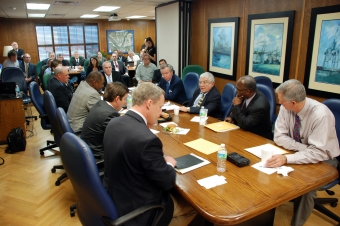Summary:
Facing a real case of joint venture (business partnership) found in the Brazilian business practice, a simulation takes place. It is intended that students recognize and combine the various interests involving a typical negotiation of joint venture formation, experimenting, during the activity, an environment that combines voltage interests and collaboration, and also develop skills such as speaking, leadership, negotiation and teamwork.
Objective:
- GENERAL GOALS: understand theoretical and practical elements of a specific business during every class, being this one dedicated to joint venture.
- SPECIFIC GOAL: students must include and combine various interests in favor of a typical trading joint venture, and experience in the development of the activity, an environment that combines voltage interests and collaboration towards a common goal.
- SKILLS AND COMPETENCIES TO BE DEVELOPED: speaking, leadership, negotiation, teamwork.
Dynamics:
- TEACHING METHOD: simulation.
- REQUIREMENTS: have read previously newspaper articles about the Shell-Cosan case (see Attachment) and suggestions of the following doctrinal texts on joint venture: (a) Luiz Olavo Baptista. Uma Introdução às "Joint Ventures". Revista de Direito Público, ano XV, n. 64, out/dez 1982; (b) Maristela Basso. Joint Ventures: Manual prático das associações empresariais. 3ª ed. Porto Alegre: Livraria do Advogado, 2002, 39-55; (c) Osvaldo J. Marzorati. Alianzas estratégicas y joint ventures: Caracterización y técnicas de integración empresaria. Joint ventures y privatización. Mercosur. Defensa de la competencia. Normas y prácticas. 1ª reimp. Buenos Aires: Astrea de Alfredo y Ricardo Depalma, 2006, p. 37-87, 106-137; (d) Raúl Aníbal Etcheverry. Contratos asociativos, negocios de colaboración y consorcios: Sociedad de componentes. Alianzas estratégicas. Consorcios de exportación. Joint ventures. Fideicomisos. Grupos de empresas y conjuntos económicos. Modelo para el Mercosur y la Comunidad Sudamericana. Buenos Aires: Astrea de Alfredo y Ricardo Depalma, 2005, p. 144-149; (e) Sergio Le Pera. Joint venture y sociedad: Acuerdos de coparticipación empresaria. 5ª reimp. Buenos Aires: Astrea de Alfredo y Ricardo Depalma, 2008, p. 74-89.
- INTRODUCTION TO THE DYNAMICS: in the first 15 minutes of class, the professor explained the dynamics informing that students should consider the information in the journalistic material, as the intentions of the parties (Shell and Cosan) regarding the format of future business partnership. All rooms of the students were divided into two groups, one taking the role of lawyers for Shell and Cosan. The two groups were subdivided into three subgroups each, considering the main theme: 1) strategic and managerial aspects of business partnership, 2) operational aspects of product distribution and 3) operational aspects of production. Once started the simulation, subgroups debated internally and inter-group and negotiated considering the interests of their respective client, always considering that everyone should be guided by a major concern, which was to reach an agreement. It was required from students they necessarily came to an agreement to be made in a joint venture format. In the end, all students in the class gave a single document to the Professor, a kind of memorandum of understanding, which was a list of points of agreement. In a nutshell, the case required concerns about the production of a well, with distribution and administration of the business partnership. The idea is that a document between two and four pages indicating what were the contractual documents and/or corporate thought to the formatting of business partnership between Shell and Cosan was presented.
- DEVELOPMENT OF THE DYNAMICS: for over 1 hour, the six sub-groups met to discuss internally the interests that would pursue the negotiation, plus a margin agreement and other aspects they deemed appropriate. Then the groups negotiated the tools they intended to incorporate to the joint venture agreement, considering the main theme to which they belonged, that is, the two subgroups on the strategic aspects of "lawyers of Shell" and "lawyers of Cosan" met to negotiate these specific aspects; the same happened with respect to the two subgroups on the operational aspects of distribution and operational aspects of production. In the end, all students in the class gave a single document to the Professor, the memorandum of understanding, which is an indication of the points to the format of a joint venture.
- END OF THE DYNAMICS: in the last 25 minutes of the class, the Professor reproduced in the blackboard the document delivered by the students, provoking the students on why they made those choices, an opportunity in which the Professor brought and discussed elements related to the joint venture and activity results, simulating future scenarios facing the decisions elected by the students. A reasonable range was necessary so that the Professor could review the document delivered in the classroom in order to discuss, in the face of possible alternatives and consequences, the choices of students.
– ATTENTION IN THE CLASSROOM: the Professor did not provide legal documents of the actual contract of the joint venture held between Shell and Cosan, because the goal was for students to cling on to journalistic material and from there reaching the results themselves. It was not about getting exactly "right" what really happened in this case. - The Professor had to restrain himself not to induce the negotiation, but rather encourage interaction between the groups. - The Professor had in mind that it was not a contractual writing class.
Evaluation:
- FEEDBACK: the professor reproduced under the document presented by the students, discussing in class the choices and recommendations.
- GRADE EVALATUTION: the Professor pondered the participation and arguments. The evaluation carried out jointly, a single note being given to every room of students, regardless of the group or subgroup in which the student figured.
Observation:
If necessary, the Professor can delete the text in English, because there will be substantial loss for the development of dynamic (v. Annex).
Copyright from the cover page image (cut):
Image: "OPENING SECOND GENERATION ETHANOL PLANT - Raízen - PIRACICABA 07/22/2015" provided by Flicker user "Secretary of Agriculture and Supply (SP)" under the Creative Commons BY 2.0 license





